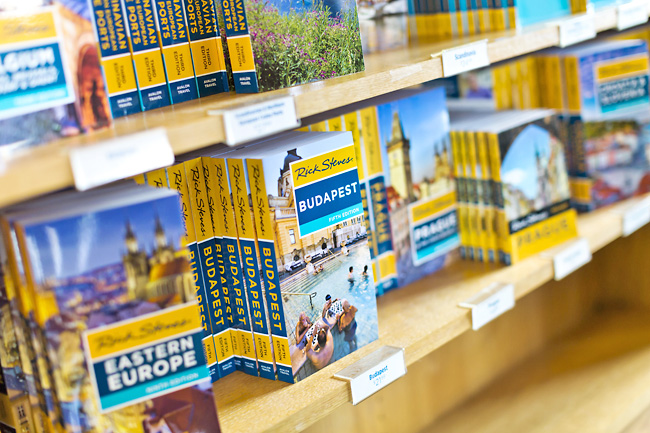Jen Rose Smith
THE WASHINGTON Submit – Rick Steves is hyped. Which is not so unusual: Infectious joy is undoubtedly one particular critical to Steves’s results as America’s kindly vacation expert. However, when he leaves quickly on a 40-working day excursion to update his European guidebooks – a ritual he utilized to execute every spring – it will be the initial these journey since COVID-19 erased his travel calendar, which clarifies his recent level of euphoria.
“Just to get back again in the saddle has got me so stuffed with journey, with vitality,” he mentioned. “I can hardly hold out.” The trip follows a pandemic-very long dry spell that quieted presses throughout the guidebook market. United States (US) travel reserve sales in 2020 were down about 40 for each cent from the previous calendar year, in accordance to NPD BookScan. (The category incorporates, but doesn’t solitary out, travel guidebooks.)
Going through stalled gross sales and the prospect of ongoing upheaval amid the pandemic, numerous guidebook print runs have been postponed or canceled. “We set all the guidebooks on pause,” said Pauline Frommer, co-president of the guidebook enterprise her father, Arthur Frommer, founded in 1957. “It was incredibly very clear from the commencing of the pandemic that matters were being heading to change greatly, and I did not want to print guidebooks that ended up not really worth the paper they were printed on.”
The pandemic knockdown arrived following unsure decades for the guidebook industry. Just after reaching 19,005,029 in 2006, US vacation ebook income halved over the up coming ten years. In 2013, BBC Worldwide bought Lonely World, a go followed by significant layoffs. Then, having acquiring Frommer’s, Google quietly stopped all output of Frommer’s print guidebooks. (The Frommers repurchased legal rights and resumed printing guidebooks.)
That’s how 2013 became the calendar year of essays trumpeting the demise of vacation guidebooks, just about every attributing bring about of demise to some mix of apps, influencers, on the net searches and electronic powerhouse Tripadvisor. But the doomsaying was very little new. “The total time I have been functioning on guidebooks, people have been like, ‘The conclude of guidebooks is nigh’,” explained creator Zora O’Neill, who wrote her initial travel guidebook in 2002 and has penned titles for equally Moon and Lonely Planet.

Though the finish never ever arrived, O’Neill noticed the business improve. Costs have fallen or stagnated in the past two a long time, though in many cases, do the job-for-employ the service of arrangements changed common royalty contracts. And the the moment-dominant part of guidebooks in travel lifestyle improved, far too.
As an previous millennial who started travelling in guidebooks’ supposedly halcyon age, I have viewed that transformation with curiosity. At times with nostalgia, much too: I skip swapping annotated, dog-eared publications with fellow travellers in bars or hostels. Now, you can reliably obtain all those same spots filled with folks glued to their screens.
20 a long time back, on the other hand, I would have claimed guidebooks contributed to an informational monoculture I observed aggravating. I discovered that individuals working with the identical brand name of vacation guides appeared to observe every single other, a bit abashed, from put to put.
On one months-extensive vacation by way of Central America in 2002, fellow house owners of Lonely Planet’s significant Central The us on a Shoestring turned familiar faces as we popped up at the very same locations in metropolis after metropolis. When new enterprises opened, entrepreneurs struggled to get the word out.
Lurid tales of questionable guidebook ethics circulated. Out-of-date or incorrect entries in a e-book could go away you stranded, but handful of other sources existed.
“When I started creating, the problem was that there was not plenty of info,” mentioned Steves, noting that, at one time, guidebooks were being just about the only way to choose wherever to stay in an unfamiliar city. As occasions improved, that sameness gave way to the untamed, thrilling diversity of today’s electronic wilderness.
“It got to the position the place there was much too significantly data,” he said, noting that proliferating sources created it tougher to know what was reliable. Researching a trip on-line can be a Mad Max infinity loop of unvetted consumer-produced testimonials and self-appointed specialists. Investing free of charge visits for sunny capabilities is prevalent exercise in the globe of travel influencers, with minimal transparency about who is footing the invoice for a offered blog site article or YouTube video.
Even though before travellers just essential some fundamental facts, Steves stated, guidebooks’ major benefit proposition might now be an escape hatch from that electronic overwhelm. “Part of my career is to curate all the solutions – the glut of information and facts – with a dependable established of values,” he claimed.
What is far more, a print guidebook delivers a probability to unplug, making it possible for travellers to put down their telephones, Steves noted. With a display screen close at hand, it’s way too simple to allow your interest drift absent from that stylish Parisian bistro and into drearily quotidian scrolling.
It would seem to be operating out, since Steves’s 2019 royalty checks were being the best of his occupation. Regardless of apocalyptic warnings, in actuality, guidebooks are generally doing all right. Soon after the rocky business information of 2013, vacation guide gross sales stabilised, then stayed around even until finally the pandemic hit.
Most travellers who nonetheless purchase print publications, although, now appear to browse them in conjunction with, not as an alternative of, on-line resources. In recent Fb and Twitter posts, veteran traveller and content creator Abigail King queried followers about how they use guidebooks today, noticing some get for pre-vacation analysis, reverting to the Online for info on the floor.
Other folks flip guides into a sort of souvenir stuffed with ticket stubs and handwritten notes.
“I use them in a genuinely diverse way now, far too, generally for reading through about the region and preparing an itinerary,” claimed King, who lives in the United Kingdom. She pointed out that, when travelling to places in Europe with consistent mobile protection, she’s unlikely to deliver a difficult copy together.
“Guidebooks are now among a suite of instruments individuals use,” explained Grace Fujimoto, acquisitions director at Avalon Journey, which oversees the Moon Travel Guides imprint that is the United States’ top rated guidebook seller. (Disclosure: I have prepared quite a few Moon guidebooks.) Fujimoto said the pandemic accelerated that change towards book-as well as-digital, partly because details has improved so swiftly in the previous two many years.
But it just underscores a broader craze of new many years, she claimed. “Guidebooks are getting much more and more inspirational, in addition to just getting repositories of info,” Fujimoto mentioned, presenting a forthcoming guidebook to Spain’s Camino de Santiago pilgrimage trail as an instance. “It does have a large amount of excellent useful details, but it brings together it with techniques of appreciating what you are seeing and carrying out just about each and every action of the way,” she explained.
Lonely Earth is a further publisher leaning into the change. “Guidebooks are evolving into this experiential, curated assortment,” reported Lonely World spokesman Chris Zeiher. This thirty day period, the organization released a new line of photo-weighty “Experience” guides, which Zeiher reported are designed to encourage.
The to start with titles in the collection, guidebooks to Italy, Portugal, Japan, Eire, Scotland and Iceland, are noticeably lacking in the outdated-design and style comprehensive listings of resorts and restaurants. In their location are skilled interviews and shorter, magazine-type options on the varieties of activities travellers may build a trip all-around.
Flip by these to get fired up for chasing waterfalls in Iceland, for occasion, or to aspiration up an itinerary centered on visiting Japanese temples. And contrary to the earliest Lonely Earth guides, which ended up oriented to extended, more thorough outings, these are tailor-made to the shorter vacations increasingly common amongst travellers from the United States.
Zeiher, way too, read predictions of print guidebooks’ demise since he joined Lonely World almost 17 several years in the past. But he’s optimistic about the coming decade. “One factor that Lonely Planet’s always performed, is we have normally developed,” he claimed. “I consider we’ll keep on to do that.”
As the pandemic recedes and travellers return to the world, he’s betting there’s room in their baggage for a e book.




More Stories
Complete Guide To Exuma’s Hidden Gem
Birkenstock Sandals Are on Major Sale
Complete Guide To Austria’s Beautiful Capital City